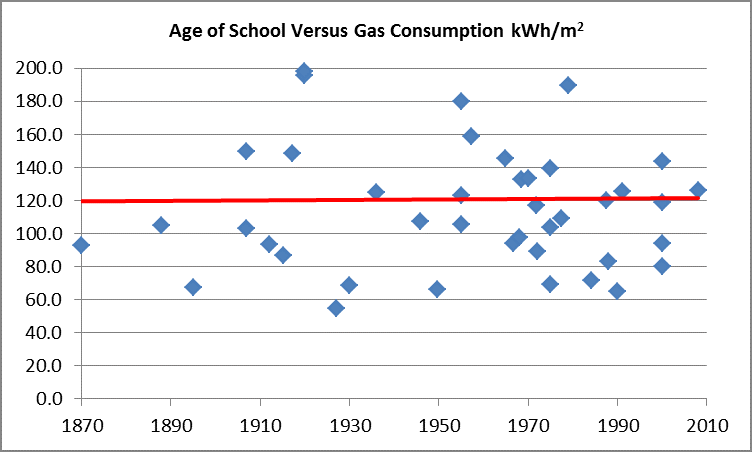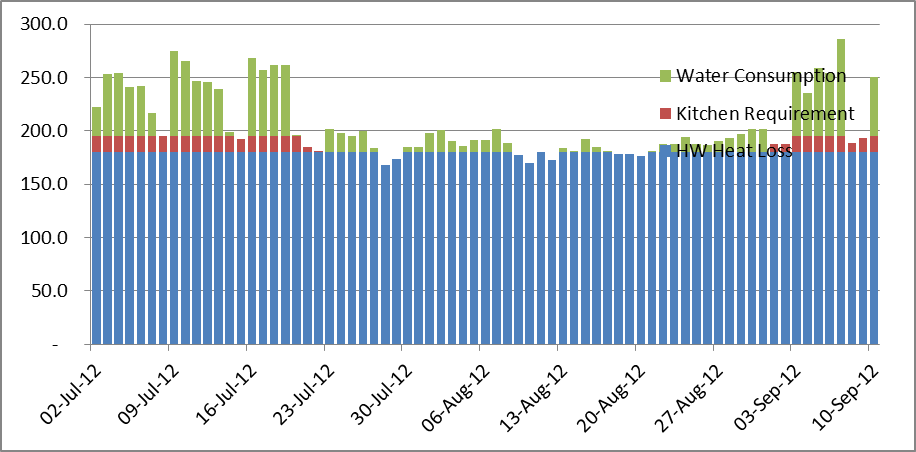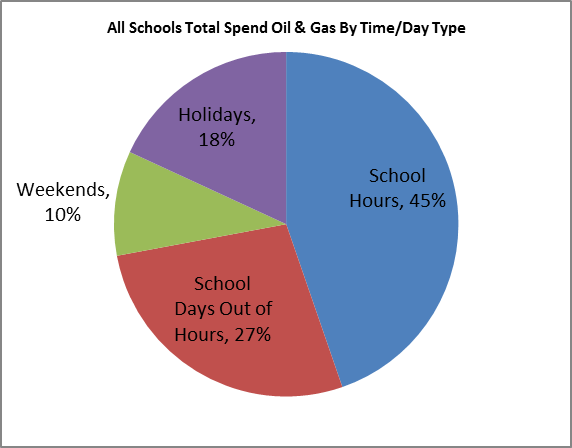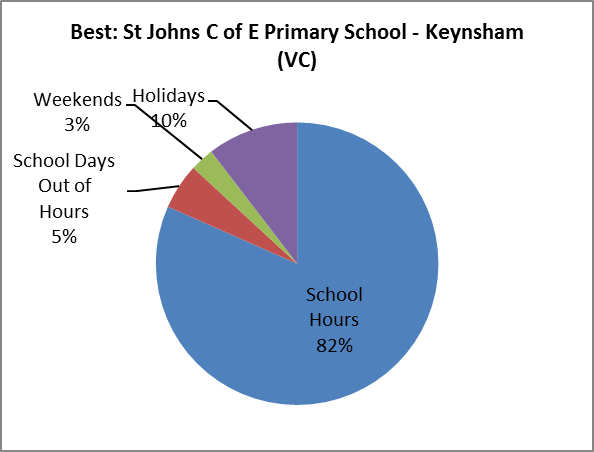With three new primary schools to be built in Bath in the next few years at Ensleigh, Mulberry Park and Cross Street, Keynsham, and with their knowledge from participation in the Verco Schools Energy Survey of 72 B&NES schools in 2013 where new schools performed badly Transition Bath’s Energy Group would like to make some recommendations on how to make new schools more energy efficient.
In an ideal world we would like all new schools to be built to Passivhaus standards which can be built at no extra cost while saving up to 80% of the energy compared with traditionally built schools. We do however recognise that many architects, developers and local authorities may not have the necessary experience to build to Passivhaus standards and therefore we would like to recommend some low cost measures which might help new schools built to lower standards reduce their energy costs.
The summary recommendations we would like to make for new build schools, based on the knowledge gained from the 2013 survey include:
- Install responsive heating which heats the building up quickly (i.e. not underfloor heating, or traditional wet systems)
- Focus on ventilation with heat recovery rather than insulation. Install good thermostatic control – TRVs on radiators often don’t work well
- Use point of use electric water heaters for the toilets rather than distributing hot water on a circulatory system from a central boiler
- Install as many heating zones as feasible, with separate time control on each, so the whole school doesn’t need to be kept warm for occasional evening or holiday use
- Use low energy LED lighting with ambient light dimming and occupancy control
- Install solar PV – as despite reduced financial support (FITs) they can still be economically installed for schools and can also serve as an educational resource
Further detailed background information appears below.
Evidence and recommendations from 2013 Energy Surveys as to why modern schools are under performing in energy efficiency
2013 Verco Energy Surveys: New schools consume the same energy as Victorian schools
We feel the council who are acting as the initial client for the school should learn from the 2013 Verco Energy survey of 72 schools in Bath that they paid for and ensure that the new school has a low energy demand. This is something which has not happened for all the recently built schools in the area. Transition Bath was involved in these energy surveys and therefore have an intimate knowledge of why modern well insulated schools have no better energy consumption than their Victorian counterparts. Many of the measures that would reduce demand cost little or nothing but need to be designed in at an early stage. Reducing energy demand is not only better for the environment but will reduce the running costs of the school freeing money up for educational purposes.
The graph below shows the gas consumption (heating and hot water) per floor area (m2) per year for each of the schools in the 2013 survey versus the date when the school was built. Exemplar new build schools elsewhere in the UK are achieving less than 20 kWh/m2/yr – 6 times better than the B&NES average.

Frustratingly it demonstrates that there is no apparent difference in gas consumption between Victorian and modern schools in B&NES, but there should be because of better levels of modern insulation. The main reasons for this lack of better performance in modern schools is down to design mistakes.
Detailed Explanation of Issues
1. Install responsive heating which heats the building up quickly
Schools are only occupied for 15% of the year, the rest of the time – overnight, weekends and holidays they are unoccupied. They are therefore unheated for long periods and need to be brought up to temperature for the short periods they are occupied. A number of recently built schools have used underfloor heating, which is unresponsive and takes a long time to heat schools up. As a result, the heating period for these modern school is often double that of the occupancy period, a good example is Batheaston Primary whose 3-year-old building has very similar heating costs per floor area (m2) to the much older Victorian half of the building – some of this is down to the underfloor heating in the new school.
The best source of heating for getting a school up to temperature is an air based system, either centrally provided via ducts and vents (MVHR) and/or by fan assisted radiators. Wet radiator systems, although not as bad as underfloor heating are still slow to heat buildings.
2. Focus on ventilation with heat recovery rather than insulation. Install good thermostatic control – TRVs on radiators often don’t work well.
B&NES currently have a policy for insulating new schools to building regulations plus 25%, but as far as we know has no guidance on ventilation.
Schools have high occupation density and thus high internal gain (30 children plus electrical equipment generate perhaps 4 kW of heat per classroom). This should be enough in most weather with reasonable insulation to not require heating. To provide a simplistic example, if you assume a classroom has an external net wall area of 35 m2 with a U value of 0.25 W/m2/K
- window area of 15m2 with a U value of 1.4 W/m2/K
- roof/floor area of 60 m2 with a U value of 0.15 W/m2/K
Then the heat loss at 5C ambient, with a 20C internal temperature is only 600W compared with the internal heat gain of 4 kW.
One consistent observation from the energy surveys is that windows are left open more often in winter in better insulated schools, which is a likely reason why modern schools underperform. Ventilation is required to maintain a healthy level of CO2 in classrooms, but this is only efficient when natural ventilation is combined with MVHR. A study of 24 classrooms from schools of differing ages, which is soon to be published will demonstrate excessive winter levels of CO2 in classrooms, including those of modern schools with designs similar to that being proposed on this site. The best performing of these schools combine natural ventilation and MVHR deliver gas consumption of 20 kWh/m2/yr 6 times less than recently built schools in B&NES.
In addition, classrooms can be made more comfortable if careful attention is paid to thermostatic control. Recommendations for improving this include weather compensated boilers, and avoiding standard radiator TRVs as these generally don’t work well in schools.
3. Hot water: avoid circulatory hot water distribution systems as they are less than 20% efficient
This is the daily 2013 summer gas consumption of a primary school built in Bath in 2010:

either side of a summer holiday when the school was unoccupied. The green represents hot water consumed by the school, the blue the gas consumed just to keep the system running – losses from the circulatory hot water system. The system is less than 20% efficient – it should be at least 90% efficient.
The lesson learnt from this is to avoid circulatory systems, which transmit hot water over long pipe runs within the school and even if insulated because of the high temperatures much of this heat is lost. Concerns over legionella in these circulatory systems make them difficult to design. Solving this problem is best achieved by point of use electric heaters, or smaller gas systems where you have a cluster of hot water taps (e.g. in the kitchen). It is likely this solution would not only be cheaper but save significant running costs – about £2,000 per year in the example of the school above, which is about 50% of their gas bill. Point of use electric hot water also reduces the risk of legionella and reduce the cost of annual legionella surveys.
4. Install as many zones as feasible, with separate time control on each, so the whole school doesn’t need to be kept warm for occasional evening or holiday use
Schools are increasingly being used out of standard hours and in holidays by the community, pre and post school clubs and teachers catching up on marking and preparation. Often during these times only 1 or 2 rooms in the whole school are occupied but the rest of the school is heated as zoning in schools is typically poor. The graphs of consumption from the 2013 Verco survey of 72 schools in B&NES demonstrate this issue:


The graph on the left demonstrates that only 45% on average of school gas consumption in B&NES is actually during and just before school hours when the building is heating up. The graph on the right is the best performing school in B&NES where 82% is consumed in school hours. Heating the school unnecessarily out of hours, accounts for 35% of schools’ gas consumption in B&NES.
As a minimum the following should be on separately timed zones:
- The hall – set at a lower thermostatic set point for activities, and for community events
- The staff room – so staff can work over holidays without the whole school being heated
- Kitchen – should have a separate heating system, and be sealed from the rest of the school, as commercial extractors often suck all the hot air out of the rest of the school
- Classrooms
- The D&A statement for this school there is designated area, which can be separated from the rest of the school for community use. We would hope this has its own heating zones which can be on a separate time schedule
Controls for these zones need to be simple to set and use, preferably with an online based calendar system, which can define holidays and events at least 1 year in advance. Linking the system to the school’s main calendar would be very helpful, so the data doesn’t need to be set twice.
5. Use low energy preferably LED lighting with ambient light dimming and occupancy control
Building regulations requires the installation of low energy lighting, which is typically via T5 florescent lighting in modern schools. We would like to see LEDs installed instead as they can be 20% more efficient and they are easier to control electronically. Occupancy, automatic ambient lighting dimming, with manual override would all make the lighting more efficient and less onerous to manage. A particular issue with primary schools is the careful placement of white boards. Often they are set opposite windows, and can’t be seen unless blinds are drawn, creating similar summer to winter lighting energy consumption, and losing the benefits of natural lighting. The north facing skylights being proposed for this development should help in this respect.
6. Solar PV can often be cost effective despite FIT reductions
Most schools have significant electricity consumption all year round; a typical single form entry primary school has a base load of 4 kW, adding significantly to the schools’ energy bills in the 85% of the time they are unoccupied. Installing perhaps 8 kWp of solar PV to offset this baseload would mean the bulk of the electricity generated would be consumed onsite offsetting electricity costs at around 12p/kWh. This onsite consumption, versus a typical site where 50% of the generated electricity might be exported at 5p/kWh significantly improves the economics of solar PV for schools making it cost effective. We would like to see solar PV installed on all new schools.
Conclusion
There are many more detailed suggestions we could make but for brevity we have limited our evidence to the 6 main points above. We would however hope that local authorities, the developers and the architects can learn lessons from the 2013 Verco survey and incorporate lessons learnt from the shortcomings of recently built schools into new school designs. Many of these recommendations will not cost more, and will significantly reduce the running costs of the school freeing up spending for materials required to support the pupils learning. Transition Bath would be happy to help and support the council with the development of this school.